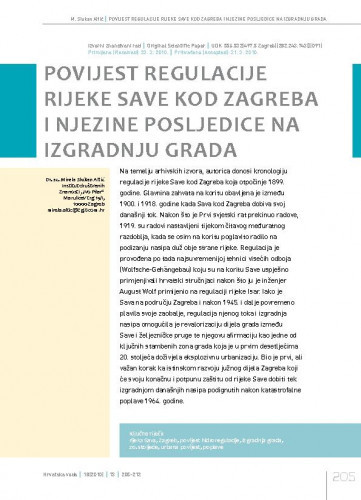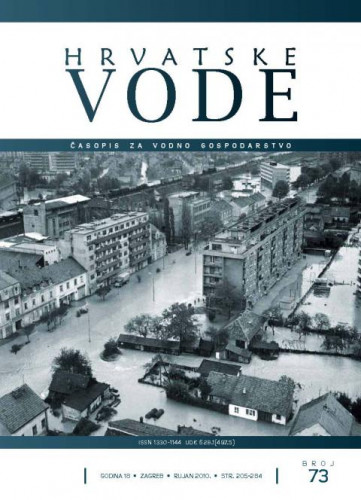Na temelju arhivskih izvora, autorica donosi kronologiju regulacije rijeke Save kod Zagreba koja otpočinje 1899. godine. Glavnina zahvata na koritu obavljena je između 1900. i 1918. godine kada Sava kod Zagreba dobiva svoj današnji tok. Nakon što je Prvi svjetski rat prekinuo radove, 1919. su radovi nastavljeni tijekom čitavog međuratnog razdoblja, kada se osim na koritu poglavito radilo na podizanju nasipa duž obje strane rijeke. Regulacija je provođena po tada najsuvremenijoj tehnici visećih odboja (Wolfsche-Gehängebau) koju su na koritu Save uspješno primjenjivali hrvatski stručnjaci nakon što ju je inženjer August Wolf primijenio na regulaciji rijeke Isar. Iako je Sava na području Zagreba i nakon 1945. i dalje povremeno plavila svoje zaobalje, regulacija njenog toka i izgradnja nasipa omogućila je revalorizaciju dijela grada između Save i željezničke pruge te njegovu afirmaciju kao jedne od ključnih stambenih zona grada koja je u prvim desetljećima 20. stoljeća doživjela eksplozivnu urbanizaciju. Bio je prvi, ali važan korak ka istinskom razvoju južnog dijela Zagreba koji će svoju konačnu i potpunu zaštitu od rijeke Save dobiti tek izgradnjom današnjih nasipa podignutih nakon katastrofalne poplave 1964. godine..; Based on archival sources, the author presents the chronology of the Sava River regulation at Zagreb, which started in 1899. The majority of interventions in the river bed were carried out between 1900 and 1918, when the Sava at Zagreb attains its present course. The works were interrupted by the World War II but resumed in 1919 and continued during the entire period between the two wars when, besides on the river bed, they mostly focused on dike construction along the both sides of the river. The regulation was implemented by utilizing the most modern technology of the day, the Wolf’s bundles, which was successfully applied to the Sava river bed by Croatian experts after it had been used in the regulation of the Isar River by the engineer August Wolf. Although the Sava continued to occasionally flood its hinterland in the area around Zagreb even after 1945, the regulation of its course and construction of the dikes facilitated a re-evaluation of the part of the city between the Sava and the railroad and subsequently its development as one of the city’s key residential areas, which underwent intensive urbanisation in the first decades of the 20th century. It was the first, important step towards the real development of the southern part of Zagreb, which achieved its final, after the catastrophic flood in 1964.
Sažetak
Dio sveska

